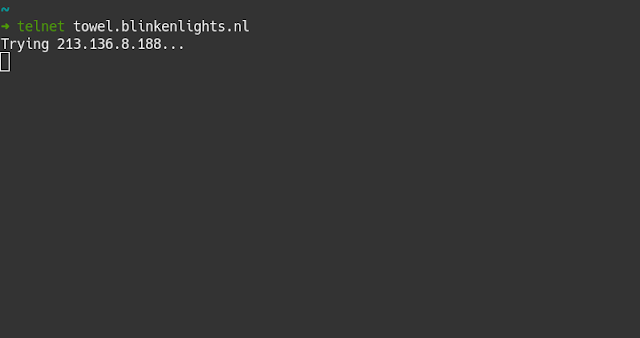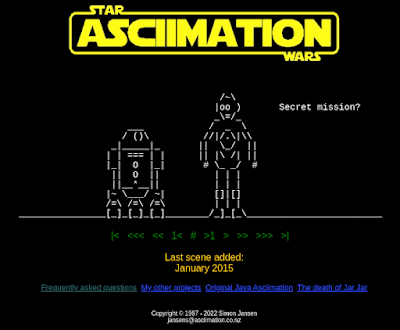2023-01-18: In A Terminal Far, Far Away...
A Trip Down Internet Lane
 |
| Fig 5. https://web.archive.org/web/20020207142105/http://towel.blinkenlights.nl/hardware.html |
 |
| Fig 6. https://web.archive.org/web/20071116171737/http://towel.blinkenlights.nl/boxen.html#towel |
 |
| Fig 8. https://telehack.com/ |
A New Hope!
| Fig 9. telnet towel.blinkenlights.nl intro (can we get Sten a hug, please?) |
The animation itself hasn't been updated in a while, but its nostalgic feel, high-quality rendition of a higher-dimensional medium, 3D scenes, and classic Star Wars text crawl are all still there. The Star Wars ASCII animation features witty scenes of dialogue between characters, high-quality animations that brought depth and 3D scenes over a highly constrained medium that takes you back to the early 2000s.
 |
| Fig 10. Scenes from towel.blinkenlights.nl |
While it is a great sign that this web experience is back among the land of the living, its intermittent availability and long disappearance speaks to the implicit unreliability of Internet services. Among such a vast web of interconnected nodes of information, not all data is equally distributed or available further speaks the necessity of web archiving. Furthermore, while the service might be back, as mentioned at the beginning of this post, most current computers will not have access to it natively.
Anecdotally, from the time I began using the web in the 90s the holistic landscape has shifted so drastically that it is almost unrecognizable. Current generations coming online today have no real context of an Internet before the presence of social media. Mention of text-based terminal interfaces, Palm Pilots, Usenet, BBS systems, and MUDs had already been virtually written out of the technology education curriculum when I was growing up. This begs the question, "how can we archive that which we do not know exists?" I suppose though, that today's youth no longer need suffer those fun, sibling arguments over who gets to use the telephone line to either connect to the Web or make a call! As the web continues to change and old technologies are replaced and marginalized to the fringes of isolated groups, we continue to run the risk of losing more and more of these technologies and the experiences which came with them. While we might be thrilled to consider the Star Wars Telnet service resurrected, not all services are so lucky. One such Telnet service was an animation for the Nyan Cat meme (Fig 11), which remains unavailable to date. Previously, the service did have some mirrors by which it could be alternatively accessed but these have all since ceased operation, in addition to the primary service.
| Fig 11. Archived Nyan Cat Telnet Server page |
The lines between reality and fictional universes the likes of Ghost in the Shell, Snow Crash, and the Matrix are blurring year by year. As we push the limits of our technological boundaries and further integrate man, mind, and machine so do we continue to transcend our mediums of interface. Just as when we look at these web technologies of old, what happens when we outgrow out current web technologies? What happens when augmented reality and virtual reality improve such that the ever-dependable rectangular screens of our fondest silicon obsessions succumb to the changing of paradigm? Will web pages or sites adapt to new and emergent environments or will web "pages" become a concept of distant obscurity as well? Interestingly, these are broad temporal evolution of the Web are also separate from the temporal elements of the web, which we look at quite a bit here at the WS-DL group. Previous work from Abigail Mabe looking at a Memento-aware web browser (arXiv paper), explored an integrated experience for looking the past-and present web. In such an envisioned future environment, how might the archived web grow and take shape? Will we still browse archived pages individually through some emulated interface, or might our technology evolve to a point which we can somehow view all historical changes to a web page simultaneously?
The Web is one of the most important resources available to us but it is also far more fragile than most people even realize. Both on the Web and beyond, many things we might not even be aware of are at risk of being lost to us. As older generations leave us, we find ourselves losing more and and more important insight that they take with them, for example. Web scientists around the world are working hard to study, grow, and preserve it but they can't do it alone. The "World Wide Web" couldn't exist without the "World" and it isn't the actions of a handful of institutional groups that can save it, often they are busy fighting to stay alive in addition to their intended mission. That is why it is critical that digital citizens from all over help out in this endeavor, it is only through our collective action that we can drive substantial change. If there is a web site that you frequently use or that is important to you, archive it. If you know of a specialized at-risk service, try reaching out to the community of that service to make a case for integrating some form of archival before the service finally goes offline. Press the importance of physical and digital archiving efforts to local policy makers. If you know a dying language, try to find online groups to help preserve and document it. If you find some old, obscure, dust-covered technology lying in your grandparent's attic, double check that it isn't the last of its kind, because it just might be. Together we can all help fight decay on the Web to make it a more robust and substantial for our present and future!
If you are a budding Computer Scientist, I hope that you might consider an interest in Web Science! Websites disappear all the time and there is always work to be done in reviving and preserving old mediums and web experiences. If you'd like to learn more about Web Science and work related to the field, explore our blog and check out work being done across a diverse spectrum of topics and specific areas of interest!
- David Calano









